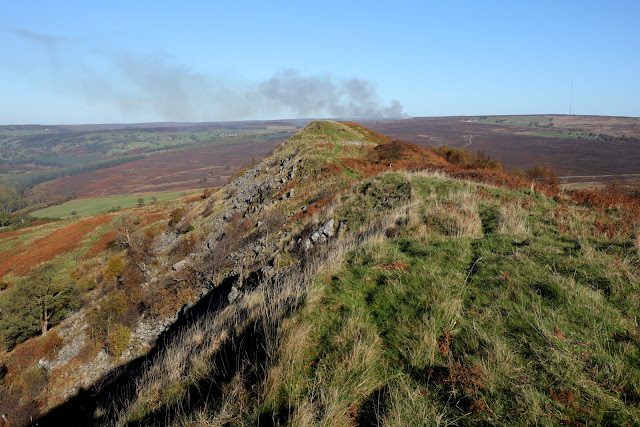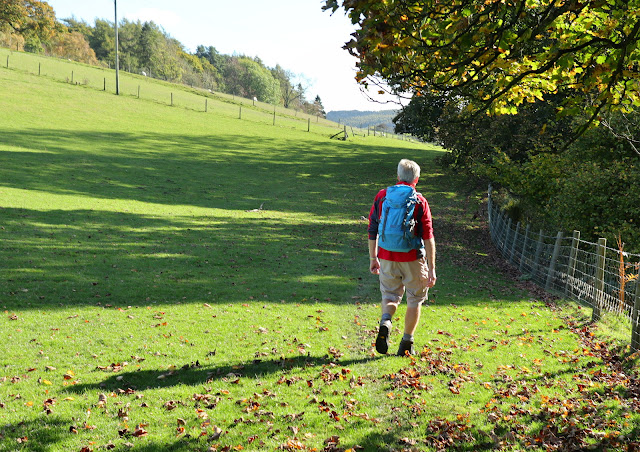Hawnby Hill and Hazel Head from Hawnby
7 miles Sunny and cool
This walk combines the best of moorland, woods, pasture and villages. It's quite good underfoot and not too difficult, but as there are a couple of good climbs, not too easy.
We arrived at Hawnby from the B1257 Stokesley to Helmsley road via the Laskill turn off and parked at the roadside near the now defunct Inn at Hawnby.
The Inn at Hawnby was integral to the village of Hawnby and it is sad to think it is a pub no more. The village seemed deserted as we walked from the car to turn off the road opposite the old Inn, and began to climb the flank of Hawnby Hill.
The village sits right under Hawnby Hill (298m) whose twin, Easterside Hill, can be seen over towards the B1257. These two hills, known as Corallian Outliers, once formed part of the Tabular Hills and have a very distinctive shape.
Crossing a field we climbed through dying bracken to reach the top and from here there is a good view in all directions; to the left down to Arden Hall and to the right, Easterside Hill.
We now had a fine ridge walk along the top of Hawnby Hill and soon reached the highest point, a cairn at 978 feet. A new addition since our last walk is a memorial bench, just by the cairn where we sat to admire the fine view down to Arden Hall.
We passed the moor gate and walked along the sandy path of Sunley Slack coming to a fork in the road after about a mile. We took the left fork and followed the path, seemingly walking straight towards Bilsdale Mast. To our right was Round Hill which is simply a collection of rocks and a bump in the heather.
Eventually we came to a series of direction posts on our right. We ignored the first two and about 20 feet past the third we turned sharp left on a small track to cross the moor.
 |
| Today's walk from The Walker's Guide to the Hambleton Hills |
 |
| The Inn at Hawnby |
The Inn at Hawnby was integral to the village of Hawnby and it is sad to think it is a pub no more. The village seemed deserted as we walked from the car to turn off the road opposite the old Inn, and began to climb the flank of Hawnby Hill.
The village sits right under Hawnby Hill (298m) whose twin, Easterside Hill, can be seen over towards the B1257. These two hills, known as Corallian Outliers, once formed part of the Tabular Hills and have a very distinctive shape.
Crossing a field we climbed through dying bracken to reach the top and from here there is a good view in all directions; to the left down to Arden Hall and to the right, Easterside Hill.
 |
| Houses in Hawnby |
 |
| We leave the road and walk up between the buildings |
 |
| Cross a field.... |
 |
| ... and climb through bracken. Looking back at the village |
 |
| Reaching the top |
 |
| Easterside Hill to our right.... |
 |
| ... and Arden Hall down to our left |
We now had a fine ridge walk along the top of Hawnby Hill and soon reached the highest point, a cairn at 978 feet. A new addition since our last walk is a memorial bench, just by the cairn where we sat to admire the fine view down to Arden Hall.
 |
| Approaching the cairn |
 |
| New memorial bench |
We walked along the ridge to the end of Hawnby Hill enjoying picking out familiar sights and walks that we could see from this vantage point, and then descended to Hawnby Moor and the moor gate at Sunley Slack.
 |
| The ridge stretched out before us |
 |
| Controlled burning in the distance |
 |
| A very steep descent |
 |
| Looking back at Hawnby Hill from Sunley Slack |
Eventually we came to a series of direction posts on our right. We ignored the first two and about 20 feet past the third we turned sharp left on a small track to cross the moor.
 |
| Approaching the moor gate |
 |
| Looking back at Hawnby Hill and Easrterside Hill |
 |
| Take the left fork |
 |
| About 20' past this post turn left.... |
 |
| ... and follow a narrow path |
There is very little sign of the path indicated by Tom Scott Burns on the map above, and we made our way sometimes through heather and sometimes on sheep tracks, all the time heading towards Hazel Head Wood which we could see to our left in the distance.
Reaching the wood we walked alongside it, gradually dropping downhill until the ruined Wesleyan Chapel suddenly came into view. Alongside the wood are numerous ants' nests, some up to three feet tall.
We stopped at the chapel and sat in the sun to enjoy our coffee and scones, with a nice view over towards Bow Gill and the Osmotherley road.
We lazed here for half an hour as it was so warm and pleasant in the sun but eventually we lumbered to our feet and resumed the walk.
We climbed back for about 100 yards to reach the gate to enter Hazel Head Woods. We soon came to some ruined buildings. TSB says these once belonged to High Hazel Head Farm which was last inhabited in 1946, surprisingly recent considering the state of the ruins.
We followed a grassy track through the dark wood until, bearing left, we exited the wood above Hazel Head Car Park and the Osmotherley to Hawnby road.
These are the trees of Blueberry Wood and we found this whole area to be full of thousands of young pheasants which ran along the path in front of us. There were feeders every few yards. Eventually we emerged from the conifers above St Agnes House Farm and to a surprise view of Hawnby Hill.
Passing above St Agnes House Farm we crossed a stile and dropped down to a ford where we crossed a footbridge into Low Wood. Soon we came to the attractive arched bridge over the Rye, not mentioned by TSB as it post dates his book, being built to replace a bridge washed away by flooding in 2005. See here
 |
| Keep moving towards Hazel Head Wood |
 |
| On reaching it descend through the bracken... |
 |
| ... until the Wesleyan Chapel comes into view. |
 |
| Wesleyan Chapel |
We lazed here for half an hour as it was so warm and pleasant in the sun but eventually we lumbered to our feet and resumed the walk.
We climbed back for about 100 yards to reach the gate to enter Hazel Head Woods. We soon came to some ruined buildings. TSB says these once belonged to High Hazel Head Farm which was last inhabited in 1946, surprisingly recent considering the state of the ruins.
 |
| Entering Hazel Head Wood |
 |
| Ruined buildings in the wood |
 |
| Emerging from the wood... |
 |
| ...to cross recent logging |
 |
| ... and reach the Osmotherley road |
From the car park we followed the road left for a short time before turning into Ellers Wood at a footpath sign. This stretch seems unwalked and the faint path is made difficult by self-seeded saplings which obstruct what used to be the footpath.
Hidden in these saplings is a bridge that a stranger to the path might find difficult to locate, as we did the first time we walked here. We found the bridge and crossed the River Rye.
Crossing the river we joined a lane and passed through a gate into a sheep field. We followed the river to reach a row of telegraph poles and turned left to follow them uphill to cross a stile and follow the path into conifers. |
| Follow the road towards Hawnby |
 |
| .. and turn off it at the footpath sign |
 |
| Follow the faint path through Ellers Wood |
 |
| Sometimes saplings make the going difficult |
 |
| We find the bridge! |
These are the trees of Blueberry Wood and we found this whole area to be full of thousands of young pheasants which ran along the path in front of us. There were feeders every few yards. Eventually we emerged from the conifers above St Agnes House Farm and to a surprise view of Hawnby Hill.
 |
| Crossing the River Rye |
 |
| Walking alongside Eskerdale Beck towards the telegraph poles |
 |
| Climbing alongside the poles |
 |
| Eventually enjoying a surprise view of Hawnby Hill |
 |
| Texel Ram at St Agnes Farm |
 |
| More rams at St Agnes Farm |
 |
| A ford then a footbridge... |
 |
| ... and the arched bridge appears |
 |
| The Bridge Over the River Rye |
From the bridge we had a short scramble up to a track leading right, coming out of the woods at the lonely Carr House. From here we followed way marks (but no path) through several fields of sheep before eventually reaching the road just outside Hawnby.
The last time we did this walk we finished with a pint at the Inn at Hawnby but today a drive was necessary to take us to the Buck at Chop Gate for our refreshments.
 |
| Carr House |
 |
| Walking through Sheep Fields... |
 |
| ... to reach the Hawnby road |
 |
| ... and a welcome pint |


No comments:
Post a Comment